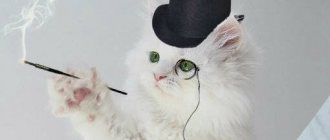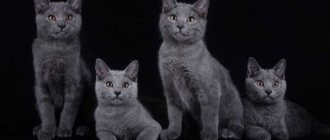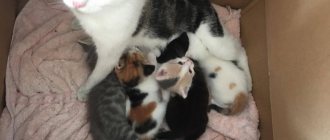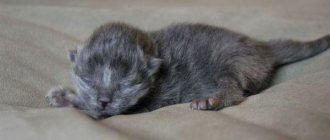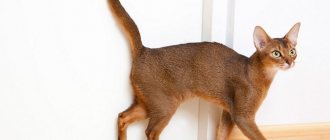Origin of the breed
The homeland of the Korat cat breed is Thailand.
The first written mentions of it date back to the 14th century. The name of the breed is given by the name of one of the provinces of the country. It is believed that the animals originated from the town of Ampur Pimai. The Thais call Korat cats “blue happiness” (Si-Sawat). In the east, it is shrouded in myths; animals were credited with magical powers: bringing wealth and good luck to their owners, protecting crops from drought and bad weather.
Animals appeared in Europe in the 19th century. Korats were presented in 1897 at the National Cat Club exhibition in Great Britain. By mistake, the contestants were mistakenly mistaken for representatives of the Siamese breed and disqualified for not meeting the standard.
Korat breeding began in the United States in 1958. The owner of the Cedar Glen nursery received two kittens of this breed as a gift. By the mid-sixties, the breed became popular. But the CFA received official recognition only in 1966. English felinologists considered Korat cats to be an independent breed only in 1976. Si-Sawat received the champion title at the national British cat show in 1983.
Owner reviews
You can leave your reviews about the Korat breed, they will be useful to other users of the site!
Olga A., Tula
“Friends of our family were on a tour in England. They brought from there an unusual, rare breed of kitten, a Korat. I really liked it, and I was eager to buy the same one. The matter turned out to be quite troublesome, and yet, after 3.5 months we received the long-awaited Venya! I still can’t get enough of it. I have never had a more loyal pet than this cat.”
Many carat owners note that cats of this breed have a playful and sociable character, but they do not favor strangers and do not like noise and turmoil. Korats become very attached to their owner and even show jealousy when he pays attention to other pets, if any.
Description and appearance
Males and Korat cats are medium-sized but muscular animals. The average cat weighs 4-5 kilograms, a cat weighs 2-3 kilograms.
The standard defines the following parameters:
- The head is shaped like a heart. The forehead is large, flat, and the lower jaw is well developed. The brow ridges form the upper part of the “heart”, the muzzle gradually tapers downwards.
- Nose with a pronounced stop.
- Large eyes set wide apart. They give the muzzle a wary or surprised look. Acceptable iris colors: green, golden-green. Kittens are born with amber or yellow eyes, which change color by the age of two or four years.
- Large ears are set high. They are wide at the base and rounded at the tips. The hair on the outside of the ears is short, the inside is almost hairless.
- The tail is proportional to the body, tapering towards the tip.
- The body lines are smooth. The chest is wide, the back is smoothly curved.
- Strong limbs are proportional to the torso, the front ones are shorter than the rear ones. The feet are oval in shape, with five toes on the front and four on the back.
Visible tail breaks and more or less toes are not allowed.
Description of Korat cats
Want to make Lady Luck your friend? Meet the Korat, a symbol of good luck in his native Thailand. And it's easy to see why. His blue-gray fur shines like silver, his bright green eyes symbolize prosperity, and his heart-shaped face is said to bring happiness to brides.
The Korat is medium-sized, muscular but compact, weighing between 2.5 and 6 kg. The breed is slow to mature and does not reach its full physical and emotional development until 5 years of age. For example, the eyes do not become a glowing green color until the Korat cat is between 2 and 4 years old.
Coat and color
Korat cats have short hair, with short, fine hairs lying close to the body. There is no undercoat. When the animal moves, the fur spreads out in “waves” along the ridge.
One color is allowed - silver-blue. Silvery hairs form a halo. The more there are, the higher the animal is valued.
British Chinchilla
Havana cat
Don Sphynx
Kittens may be born with an undefined tabby pattern. By the year it goes away.
Any deviation from the color is a reason for disqualification. White hairs, spots, medallions are unacceptable.
The lips and nose are dark blue, perhaps lavender. The standard sets color options for paw pads from dark blue to lavender with a pink undertone.
Character and temperament
Korat cats have a wonderful character, they are gentle and charming, they are strongly attached to those from whom they feel love and affection and are very bored if these people are not with them for a long time. This is a very loyal cat breed that can give him a sea of love and affection.
Korats are inquisitive and highly intelligent cats, they are energetic and moderately active.
Koraths have a cheerful disposition, they are sociable and observant and nothing can pass unnoticed by their eyes. Despite the fact that Korat cats are not capricious and loud, they have a good range of sounds, and always manage to explain their needs to their owners. Owners of cats of this breed say that the expressive face of cats, their interesting and intelligent look will do everything to clearly tell what exactly they need.
Characteristics
Korats become attached to their owner and need attention and affection. Human company is important for a pet; prolonged loneliness has a detrimental effect on the psychological state of cats. The animal will enjoy spending time surrounded by all family members.
By nature, male cats are confident and purposeful. They are smart and easy to train. They are easy to teach to rules and routines.
Animals have developed emotional intelligence. They sense the owner’s mood and help relieve stress.
Animals do not strive to climb to heights. She will attract the cat if she needs to explore a new object. Korats prefer to watch what is happening while lying on the sofa or the floor, or the owner’s lap.
Representatives of the breed are frightened by loud, sharp sounds. They hide when they hear a vacuum cleaner or the sound of a drill. Animals cannot stand swearing or screaming. An unfavorable emotional climate in the home leads to deterioration in the health of pets.
The attention of all family members is important to Korat. They get along with children, but do not tolerate unceremonious attitudes. Aggressive behavior is responded to with aggression. Guests, especially noisy ones, irritate them. The cats try to hide until they leave.
Males and Korat cats get along only with their own kind. Representatives of other breeds irritate them. They do not get along with dogs and perceive guinea pigs and parrots as prey.
Korats are talkative, but meow loudly in extreme cases (illness, hunger). Cats attract attention with quiet, melodic sounds.
Animals do not want to go outside. They will not run out of an open door or window. But they love to lie on the windowsill and watch street life.
Character
The main features of the breed are the Korats’ sociability, their affection for people and devotion. Happy cats are very playful, inquisitive and follow their owners' heels in search of entertainment.
They consider their favorite family member to be their property, are jealous, and therefore do not get along well with other animals that claim to be a pet. These cats have amazing restraint and intelligence. They are easy to train.
Korats love to be the center of attention and seek it in every possible way. Loneliness is a big stress for them. The character of the Korat is also distinguished by its gentleness and sensitivity; they observe people and understand them at a glance. They will keep you company in any business and turn any cat hater into an ardent connoisseur.
Maintenance and care
Korats value comfort. Instead of mazes or climbing structures, your pet should buy a comfortable bed. It is better to place the basket in a secluded place.
The pet should have enough toys. Smart Korats prefer “intellectual” entertainment.
Cats are smart, quickly accustomed to the tray and feeding regime. They understand the prohibitions. You won't be surprised by your pet at the dinner table. If there is a scratching post, animals will not damage furniture or wallpaper.
Korats are not suitable for walking on their own. Breeders recommend walking your pet on a harness two or three times a week. You can accustom a kitten to such walks after six months.
To prevent the animal from getting bored, two representatives of the breed are adopted at once. This makes it easier for the Korats to endure loneliness.
Raising a kitten begins at an early age. If you don't teach your pet to discipline right away, he will act out. It is difficult to wean a Korat from “bad habits”.
Care and hygiene
Short, fine coat without undercoat does not require frequent brushing. It is enough to do this once every 5-7 days. A soft brush with natural bristles or a special rubber mitten will do. During the molting period, the cat is brushed three to four times a week.
Cats and cats do not need frequent washing. Water procedures are indicated as contamination occurs. After bathing, the animal is dried with a terry towel, wrapped in it for 5-10 minutes. The fur does not need to be combed. After drying, it is given shine using a piece of suede fabric.
The pet's eyes and ears are examined daily. Every other day they are wiped with a cotton pad soaked in a special solution. Use a separate cotton swab for each eye and ear.
The animal's teeth are brushed once a week with a special paste. The kitten is accustomed to the procedure from three to four months. Nails need to be trimmed every 7-9 days.
Nutrition
Most breeders recommend feeding Korats with premium food. Choose from lines for short-haired, active breeds.
If a natural diet is assumed, then 90% of it should consist of lean meat.
The diet includes:
- beef, veal;
- chicken or turkey meat;
- rabbit meat;
- lean pork;
- offal (liver, kidneys).
Three or four times a week the pet is given eggs, cottage cheese, milk or fermented milk products. Boiled or stewed vegetables and cereals are allowed once every seven days. They are given as an addition to meat. Fish and seafood are included in the diet three or four times a week.
An adult cat is fed two or three times a day. Kittens and pregnant or lactating cats require more frequent feeding up to four times a day.
In addition to the natural diet, the animal is given multivitamin complexes twice a year. Veterinarians recommend planting special grass for cats. It is especially relevant in the winter-spring period.
Health and life expectancy
On average, Korats live 15-17 years. Some pets lived up to twenty years.
Representatives of the breed must be protected from hypothermia and drafts. They are prone to colds.
Cats and cats often have food allergies. They are manifested by hair loss and redness of the skin. This feature complicates the selection of dry food.
Animals are predisposed to the following genetic diseases:
- gangliosidosis (retardation in physical development);
- atelosteogenesis (improper bone formation).
The first vaccinations are given to Korats at six months. Revaccination is carried out after 3-6 months.
If the animal is not planned to participate in breeding, it will be castrated. Cats are neutered or spayed at 8-10 months of age. It is better to do this before the first heat. Males are neutered before they reach one year of age. The optimal age is 7-10 months. If you monitor your pet’s diet and avoid overeating, obesity and related diseases will not overtake him.
How to choose a kitten
Choosing a Korat kitten should begin with setting the purpose of its acquisition. This is a rare breed; most Korats are bought for further breeding or an exhibition career. Taking an animal “for yourself” is an expensive purchase, but precedents still happen.
If the purpose of the purchase is participation in exhibitions or breeding, then the first thing you need to focus on is the documents for the kitten. Study the Korat's pedigree, be sure to meet the baby's parents, and at least look at the photos of the parents' Korats. A kitten without documents automatically becomes unsuitable for such purposes from the point of view of specialists, although it will cost much less.
If you want your Korat kitten to take prizes in the future, study the pedigree. If there were exhibition winners in the pet’s family, the cat’s chances of a future victory automatically increase.
After you are sure that everything is in order with the documentation, you need to examine the kitten itself. Pay attention to such nuances as:
- Stomach. The kitten's tummy should not look like a ball. Bloating is the first sign of possible gastritis or other gastrointestinal diseases.
- Mouth. The optimal color for a kitten's mouth is pink. A Korat kitten’s mouth should also not stink. Any deviation in color and the presence of an unpleasant odor indicate health problems.
- Anal hole. The area under the ponytail should be clean and dry. Crumpled hair around the anus indicates that the baby is suffering from diarrhea.
- Body condition. The baby's skin should be completely covered with hair without any bald spots. Feel the kitten; any tumors and swellings are an alarming signal.
- General state. It is better not to buy a lethargic kitten. But there is one nuance here. If you see that the kitten is generally healthy and suitable for you, but is acting lethargic, wait a little. The baby may have recently woken up or eaten a heavy meal, but lethargic behavior of the animal after eating and sleeping is normal.
Don't forget about the character of the animal. The character of a Korat can be noticed immediately by observing how the baby behaves. Take a pet that is moderately active, not very lethargic, but not hyperactive either.
Breeding
Crossing Korats with other breeds is prohibited. Animals that 100% comply with the breed standard are allowed for breeding. Before mating, it is necessary to have your pet examined by a veterinarian; vaccinations are given two or three months before mating. In addition to the usual examination, cats are shown an ultrasound of the abdominal organs.
Korats are fully mature by the age of three or four years. It is not recommended to breed a female before this age. The gap between pregnancies in a cat should be a year. This will allow the animal's body to recover.
Pregnancy in Korat cats lasts 65 days. As a rule, this period passes without complications. It is better if the birth takes place in the presence of a veterinarian.
Representatives of the breed do not leave their kittens for the first weeks of life. They are ready to protect them and can react aggressively to strangers.
Characteristics of the Korat
Korat cats have a soft and pleasant character and easily win the love of their owner and the rest of the household. They have the ability to sense a person’s mood and help him relieve stress and fatigue after a hard day. Korats love communication and interaction with their owner and become sensitive companions. They are recommended for single people, including pensioners, if they can devote enough time to their pet.
These are very active and intelligent animals. They love games and are very curious. Therefore, there is a high probability that these cats will run around the house and get into the most inappropriate places. In addition, they are notorious thieves who love to hide their prey in secluded corners.
It is better to channel your irrepressible energy into a peaceful channel by regularly playing with your pet. Possessing great intelligence, these pets are trainable and can learn a few simple commands. For example, bringing a thrown ball back. There are usually no difficulties in training a cat to use a litter box; and some of the individuals even master using the toilet.
Korat cats have a peculiar mental organization. They cannot stand noise, sudden movements and screams. But they themselves love to make noise and even talk. All of them are owners, so they are not good friends with other pets and are jealous of the other inhabitants of the house towards the owner. It is better to have two representatives of this breed so that they can entertain each other.
Where to buy a kitten
The breed is considered rare in Russia and the CIS countries. One Moscow nursery, “Silvernertus”, deals with it.
The price of a kitten starts at 400 US dollars. The offspring of champions are many times more expensive. Rejected and excluded individuals from breeding are cheaper. But a mandatory condition for acquisition is castration or sterilization of the animal.
Some breeders of other breeds are ready to bring a kitten from abroad. Before using their services, check the authenticity of the documents and read the reviews. Fraudsters pass off rejected representatives of the Russian Blue or Burmese breed as Korats.
Please check the authenticity of the certificates and pedigree before purchasing. The kitten must have a veterinary passport with notes on vaccinations and previous diseases.
Korat cats are beautiful, graceful, and intelligent. They will be true friends. The breed is suitable for single people and families with children. But it is worth remembering that pets deprived of attention get sick more often and their life expectancy is reduced.
Health
The Korat breed is characterized as healthy and today there are only 2 hereditary diseases - atelosteogenesis (a hereditary disease characterized by incomplete, impaired bone formation) of the first and second types. Unfortunately, both types of the disease are fatal to cats. Their manifestation is dictated by genetic mutation.
In this case, the lethal outcome of cats in the event of the disease is observed only if they inherit defective genes from both parents. In the event that genes are inherited from only one parent, the cat will only be a carrier of defective genes and will not be in any danger. Korat cats, no less than others, need all veterinary preventive measures. They need to be vaccinated according to schedule and regularly get rid of external and internal parasites. Be sure to monitor the quality of food and the purity of drinking water. With proper care and maintenance, the cat will delight the owner with its health and excellent mood for a long time.
Average life expectancy is 13-14 years.
